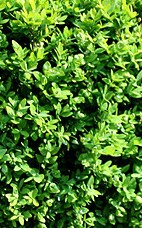 Boxwood (Buxus sempervirens), as it is called in America, is a slow growing evergreen shrub or small tree (15-30 feet tall) native to North Africa, western Asia, and Europe where it often grows on chalk or limestone soils usually as an understory tree. It thrives in England but there is disagreement among scholars as to whether or not it is native there. The plant has one-inch long, oval or oblong leaves that are notched at the center, and have dark green topside and pale green underside. The scent of the leaves is sometimes likened to dog urine. The small greenish yellow flowers lack petals and are borne in clusters in the axils of the leaves. Boxwoods like moist, well-drained soil and sun or shade but must have consistently moist soil when grown in full sun. It is hardy in USDA zones 6-8
Boxwood (Buxus sempervirens), as it is called in America, is a slow growing evergreen shrub or small tree (15-30 feet tall) native to North Africa, western Asia, and Europe where it often grows on chalk or limestone soils usually as an understory tree. It thrives in England but there is disagreement among scholars as to whether or not it is native there. The plant has one-inch long, oval or oblong leaves that are notched at the center, and have dark green topside and pale green underside. The scent of the leaves is sometimes likened to dog urine. The small greenish yellow flowers lack petals and are borne in clusters in the axils of the leaves. Boxwoods like moist, well-drained soil and sun or shade but must have consistently moist soil when grown in full sun. It is hardy in USDA zones 6-8
Shakespeare mention box in Twelfth Night (act ii, sc. 5, 18). In preparation for the practical joke to be played on Malvolio, Maria tells Sir Toby Belch, Sir Andrew, and Fabian;
Get you all three into the boxtree. Malvolio’s coming down this walk.
Box is known in England from ancient times when boughs of box were thrown into Roman graves. The botanist, Gerard, a contemporary of Shakespeare, mentions box in regard to its questionable medicinal uses and comments on the evil smell, and poor quality of the wood. Ironically, one of the chief uses of box is for its wood that was highly valued for engraving as well as instrument making. In Shakespeare’s time box was probably used mostly as an ornamental shrub in the garden because of its evergreen nature, small leaves, and tolerance for shearing that made it a good subject for topiary.
The genus name Buxus is derived from the Greek puxos meaning box tree; the specific name sempervirens means ever- living and refers to the evergreen nature of the plant. The common name, boxwood, refers either to the use of the wood for boxes or to the fact that the stems of young plants are a square box in cross section.